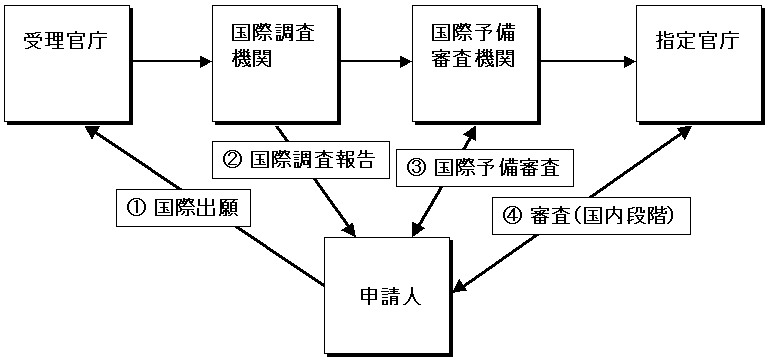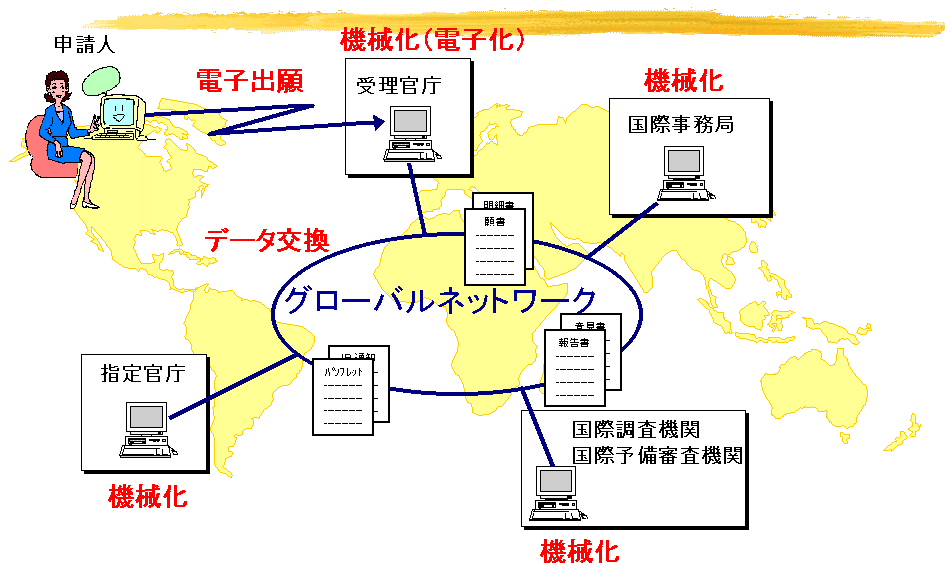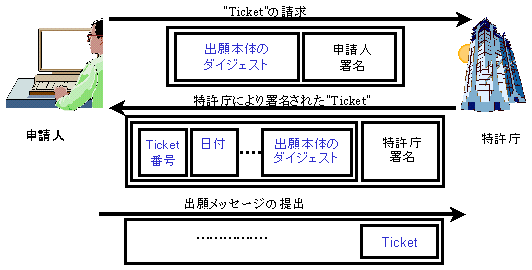ここから本文です。
国際出願の世界的な電子化について
(PCT Automation (PCT機械化)にむけた日本提案)
1999年6月
電子計算機業務課
1.背景
日本国特許庁は、平成2年12月より、特許・実用新案の電子出願を行ってきたところ、来年1月より、意匠、商標もオンラインによる電子出願を開始する予定である。これにより、特許、実用新案、意匠、商標の工業所有権四法全てにおいてオンラインによる電子手続が可能になる。
一方、特許協力条約 (PCT: Patent Cooperation Treaty:別紙1参照)に基づく国際出願の手続きのほとんどは、未だ書面で行われており、ユーザ、各特許庁並びにWIPO事務局の事務の繁雑さを考慮した場合、我が国の他の出願と同様、ペーパレス化が図られるよう求められている。
2.PCT機械化に向けて(別紙2参照)
このような背景の下、日本国特許庁は、米国特許商標庁、欧州特許庁に働きかけ、この三極で、電子出願を含むPCTの手続きの全体的な電子化 (「PCT機械化 (PCT Automation)」という)の検討を行ってきた。今般、三極の検討をベースとしたPCT機械化に係る日本国特許庁提案(日本国特許庁提案書-英語版-、提案書翻訳文-日本語-)を、この7日伊佐山特許庁長官より、イドリス世界知的所有権機関 (WIPO: World Intellectual Property Organization)事務局長に提出した。また、6月14、15日にジュネーブで開催のWIPO情報技術常設委員会の場でも、同様の主張を行ったところ。
(1)電子出願、(2)官庁間のグローバルネットワークを通じた出願書類の電子的交換、(3)各国官庁内の機械化(電子化)が、PCT機械化に係る日本国特許庁案の大きな柱である。
このうち
(1)電子出願について、その技術仕様を三極で検討中である。5月26日から28日にオランダのハーグで行われた三極会合では、日本提案を基礎に、PCTの電子出願を「チケット」(別紙3-1,2参照)、「電子署名」等を利用したインターネット出願とすることで合意した。三極は、技術仕様の細部について更に検討し、今年中にとりまとめ、WIPOに提出する予定である。
日本国特許庁は、世界で初めてペーパレス化をし、これまで培ってきた経験を活かして、21世紀の早い段階に、電子出願を含むPCT機械化が実現するよう、三極やの場で、引き続き積極的に貢献して参りたい。
別紙1
PCTにおける国際出願の流れ

- (通常自国の)受理官庁に国際出願をする。その際、複数の国を指定できる。
- 国際調査機関で国際調査を行う。
- 申請人の請求がある場合、国際予備審査機関で国際予備審査を行う。
- 指定された国の官庁(指定官庁)に移り、審査を行う。
(注)日本国特許庁は、国際調査機関・国際予備審査機関でもある。したがって、日本国特許庁が受理官庁の場合、通常1.~3.まで日本国特許庁で行われる。日本が指定されている場合は、4.の段階も日本国特許庁で行う。
別紙2
PCT機械化

Towards PCT Automation
Japanese Patent Office
June 7, 1999
PCT Automation
1.Introduction
PCT Automation, or the automation of all the PCT processes, is a concrete example of SCIT's vision, which assigns goals to each of the SCIT projects. For example, PCT Automation includes the following.
- (a)PCT electronic filing
- (b)IP Office Automation
- (c)Data Exchange between IP Offices via the WIPONET
- (d)Publication via IPDL
PCT Automation will enable each IP Office and the International Bureau (IB) of WIPO to reduce the workload that is resulting from the increase in PCT applications. Technical, personnel, and financial support for the IP Offices that are unable to implement an automated PCT system with their own resources will mean that users in more countries will be able to enjoy the benefits of PCT Automation. This will also contribute to the enhancement and popularization of the PCT system.
2.PCT electronic filing
The current increase in the use of the Internet and the rapid development of Information technologies make it likely that PCT electronic filing will in future take place mainly via the Internet or the dedicated line. As is the case with PCT-EASY, it is assumed that WIPO will develop electronic filing software, which would be distributed to applicants by ROs that allow electronic filing.
3.IP Office Automation
In order to make PCT Automation more efficient, it is important that automation be implemented at ROs, DOs / EOs, and ISAs/IPEAs as well as the IB. Major offices such as the Trilateral Offices would likely be able to implement their own proprietary automation systems, but there will be a need for WIPO to support small offices where requested. The following are examples of the systems that will be needed to automate each Office.
- (a)Data entry system, acceptance system, formality check system in RO
- (b)Application management system in DO / EO
- (c)Editing system for ISRs/IPERs by ISAs/IPEAs
Annotation:
Data entry system: changes paper form into electronic form, e.g. OCR.
Acceptance system: receives online applications.
Editing system: used by examiners to prepare ISRs/IPERs.
4.Data Exchange between IP Offices via the WIPONET
Currently, ROs, DOs / EOs, ISAs/IPEAs, and the IB exchange most documents in paper format, resulting in an increase in workload as PCT applications increase. If these paper documents could instead be exchanged via WIPONET, it would reduce the workload at each Office. It would also make reusability of the documents greater.
Documents exchanged via WIPONET would include, for example, applications, ISRs, IPERs, PCT pamphlets, IB notifications, and priority documents. The exchange of these documents is one of the principle goals of WIPONET.
For the IP Offices which exchange only a small volume of documents, the use of a media such as CD-ROMs instead of WIPONET would be a practicable alternative.
5.Publication via IPDL
The IB is able to use electronic data obtained from the applications filed through the PCT electronic filing system and data received from ROs and ISAs/IPEAs via WIPONET in order to prepare international publicaiotns. Additionally, storing this electronic data in a database and making it accessible via WIPO's homepage would enable international publication via the IPDL in the IB. One of the concrete goals of the IPDL project is international publications via the IPDL in the IB.
Another concrete goal of the IPDL project is to construct IPDLs at the DOs/EOs and to disclose the status of PCT applications in national phase.
In order to realize these goals, an application management system will also be needed in addition to the IPDL at each Office. Where Offices are unable to implement this system with their own resources, WIPO should give support on request, or the IPDL in the IB should disclose the status information for those Offices.
6.Conclusion
PCT Automation will bring benefits not only for IP Offices, but also for applicants and other users of the PCT system. Also, the process of implementation will see improvements to the organization and facilities at each Office, which will serve to enhance and popularize the PCT system. Accordingly, PCT Automation is an important goal to be achieved at WIPO.
Symbols and Abbreviations
- RO : Receiving Office
- DO : Designated Office
- EO : Elected Office
- ISA : International Searching Authority
- IPEA : International Preliminary Examining Authority
- ISR : International Search Report
- IPER : International Preliminary Examination Report
PCT Automationに向けて
日本国特許庁
1999年6月7日
PCT Automation
1.Introduction
PCT Automation、言い換えると、PCTの手続き全体に渡るautomation は SCIT's visionを示す具体例であり、その内容は、SCITの各プロジェクトの具体的なgoalsを与えるものである. 例えば、PCT Automationには、次のようなものが含まれる.
- (a) PCT electronic filing
- (b) IP Office Automation
- (c) Data Exchange between IP Offices via the WIPONET
- (d) Publication via IPDL
PCT Automationを実現することにより、現在、PCT applicationの増加に伴い増加している各officeの作業負担を減らすことができる。
また、自力でimplementできないofficeに対しては、技術的、人的あるいは金銭的な支援をすることにより、PCT Automationの利益をより多くの国のユーザと共有すると共にPCT制度の強化、普及にも一役担えるものと期待できる。
2.PCT electronic filing
現在のインターネットの普及及びインターネット技術の発展をみると、PCTのelectronic filing、特にonline filingはInternet経由が中心になるであろう。PCT-EASYと同様に、WIPOがelectronic filing softwareを開発し、electronic filingを受け入れるROから出願人に配布されるようになるだろう。
3.IP Office Automation
PCT Automationをより有効なものにするには、IBだけでなく、RO, DO / EO and ISA / IPEA Automation を実現することが重要である。Trilateral offices等のmajor officesは、独自でautomationのimplementができるであろうが、small officesは要請に応じてWIPOが支援する必要があるであろう。各office automationに必要なシステムとしては、例えば、以下のようなものが考えられる。
- (a) Data entry system, acceptance system, formality check system in RO
- (b) Application management system in DO / EO
- (c) Editing system for ISR / IPER in ISA / IPEA
Annotation:
Data entry system: it changes paper form into electronic form, e.g. OCR.
Acceptance system: it receives online applications.
Editing system: examiners prepare ISRs / IPERs using it.
4.Data Exchange between IP Offices via the WIPONET
現在、RO, DO / EO, ISA / EO and IBの間では、ほとんどの書類を書面で交換しており、PCT applicationの増加に伴い、作業量も増加している。書面で交換している書類をWIPONET経由で交換できれば、各officeの作業負担の軽減となる。また、各officeでの書類の再利用性が高くなる。
WIPONETで交換する書類は、例えば、Application Documents, ISR, IPER, PCT pamphlet, IB notification, Priority Documentsである。これらの書類の交換は、WIPONETの1つの具体的なゴールである。
ただし、交換する書類が少ないofficeの場合は、WIPONETを使わず、CD-ROMのようなmediaを使うことも合理的な方法の1つである。
5.Publication via IPDL
PCT electronic filingによって得られたelectronic data、ROやISA / IPEAからWIPONET経由で受け取ったelectronic dataを、IBはInternational Publicationのために利用することができる。また、これらのelectronic dataをdatabaseに格納し、WIPOのHomepageからアクセス可能にすれば、IPDL in IBによって、International Publicationをすることができる。International PublicationをIPDL in IBで行うことは、IPDL projectのa concrete goalである。
DO / EOにおいて、IPDLを構築し、DO / EO段階になったPCT applicationのstatusを公開することは、IPDL projectのanother concrete goalである。
これの実現のためには、IPDLの他にapplication management systemが必要である。自力で実現できないofficeには、要請に基づいてWIPOが支援するか、IPDL in IBでそのofficeのstatusを公開するようにすべきである。
6.Conclusion
PCT Automationは、IP officeだけでなく、applicantを含む全てのPCT systemのユーザに利益をもたらすものである。また、その実現への過程の中で、各officeの体制や設備が整備され、、PCT systemの強化・普及に役立つものである。従って、PCT Automationは、WIPOにおいて実現すべき事項の1つである。
Symbols and Abbreviations
- RO : Receiving Office
- DO : Designated Office
- EO : Elected Office
- ISA : International Searching Authority
- IPEA : International Preliminary Examining Authority
- ISR : International Search Report
- IPER : International Preliminary Examination Report
別紙3-1
PCTにおける電子出願の基本仕様に合意
-日本提案の「チケット」採用-
5月26日から28日にオランダのハーグで三極特許庁(日本国特許庁、米国特許商標庁、欧州特許庁)の専門家会合が行われた。その中で、特許協力条約(PCT)における国際出願において、電子出願を実現するため、三極は日本提案を基礎とした技術仕様の基本的事項に合意した。
その主な内容は、電子出願を、「チケット」、電子署名等を利用したインターネット出願とすることである。現在、インターネットでは、大量のデータを送信する場合、送信時間が膨大となったり、送信自体が失敗することがあるが、このチケットは、その対策として日本で考え出されたものである。このチケットを使うことで、大量の出願データを送る場合においても、インターネットの混み具合等に関わらず、申請人は出願日を確保することができる。
今後、三極は、技術仕様の細部について更に検討し、今年中にとりまとめ、世界知的所有権機関(WIPO)に提出する予定である。
参考
同じ内容の発明が出願された場合、早く出願した方を特許とするのが原則。したがって、申請人にとって出願日は重要なことであり、インターネットの通信状況によって出願日が遅くなることは、申請人にとって不利益である。
別紙3-2
インターネット出願における伝達の保証
「チケット」とは?
インターネットを通じて出願する場合、出願データが大きいと、データが正常に送れないということが起こりうる。そのために考え出されたものが、「チケット」を使った出願である。
「チケット」を使った出願とは、概略次のような手順を踏んで電子出願を行うもの。
- 申請人は、ハッシュ関数を用いて出願の電子データを短い一定長さの電子データに変換する。ハッシュ関数を用いて変換したあとの電子データ(以下、「ダイジェスト」という)は、元の電子データが少しでも異なると一致しないという性質を持つ。申請人は、まずこのダイジェストに電子署名を添えて特許庁に伝送する。ダイジェストは長さが短いので、インターネットでも伝送は確実に行える。
- 特許庁はこのダイジェストに電子的なタイムスタンプを押して、申請人に返送する。この返送データを「チケット」と呼ぶ。
- 申請人は、このチケットを添えて、元の出願の電子データを特許庁にインターネットを介して送る。特許庁では、受け取った出願の電子データをハッシュ変換する。このとき得られたダイジェストと、チケットのダイジェストを比較し、一致したならば、そのチケットにタイムスタンプされた日を出願日として認定する。出願データの量が膨大で伝送に時間がかかったとしても、チケットがあればタイムスタンプがされているため、出願日は確保される。

[更新日 2001年1月6日]
|
お問い合わせ |
|
情報システム課 情報技術企画室 調査班 電話:03-3581-1101 内線2507 e-mail:PA0I00@jpo.go.jp |